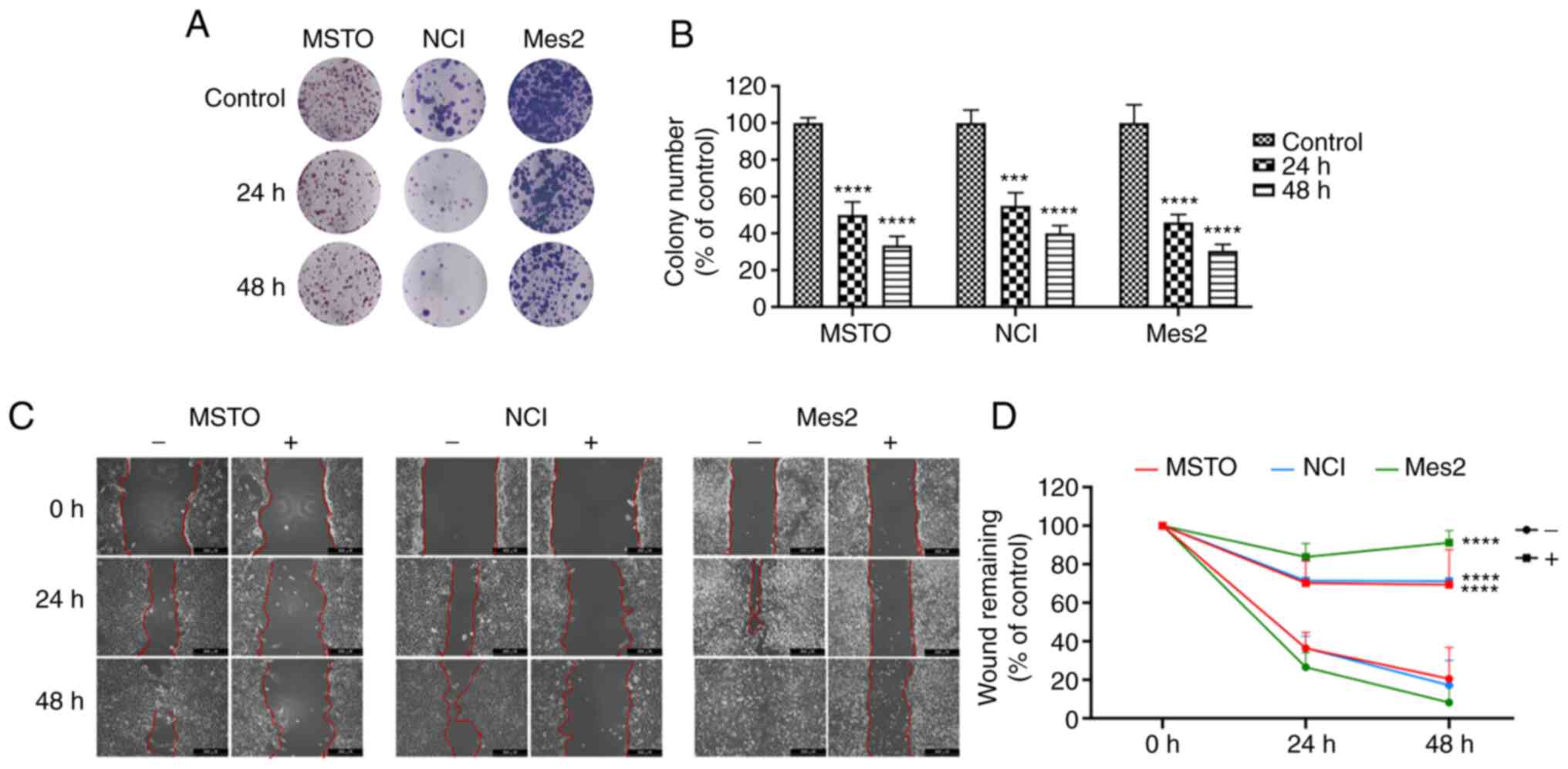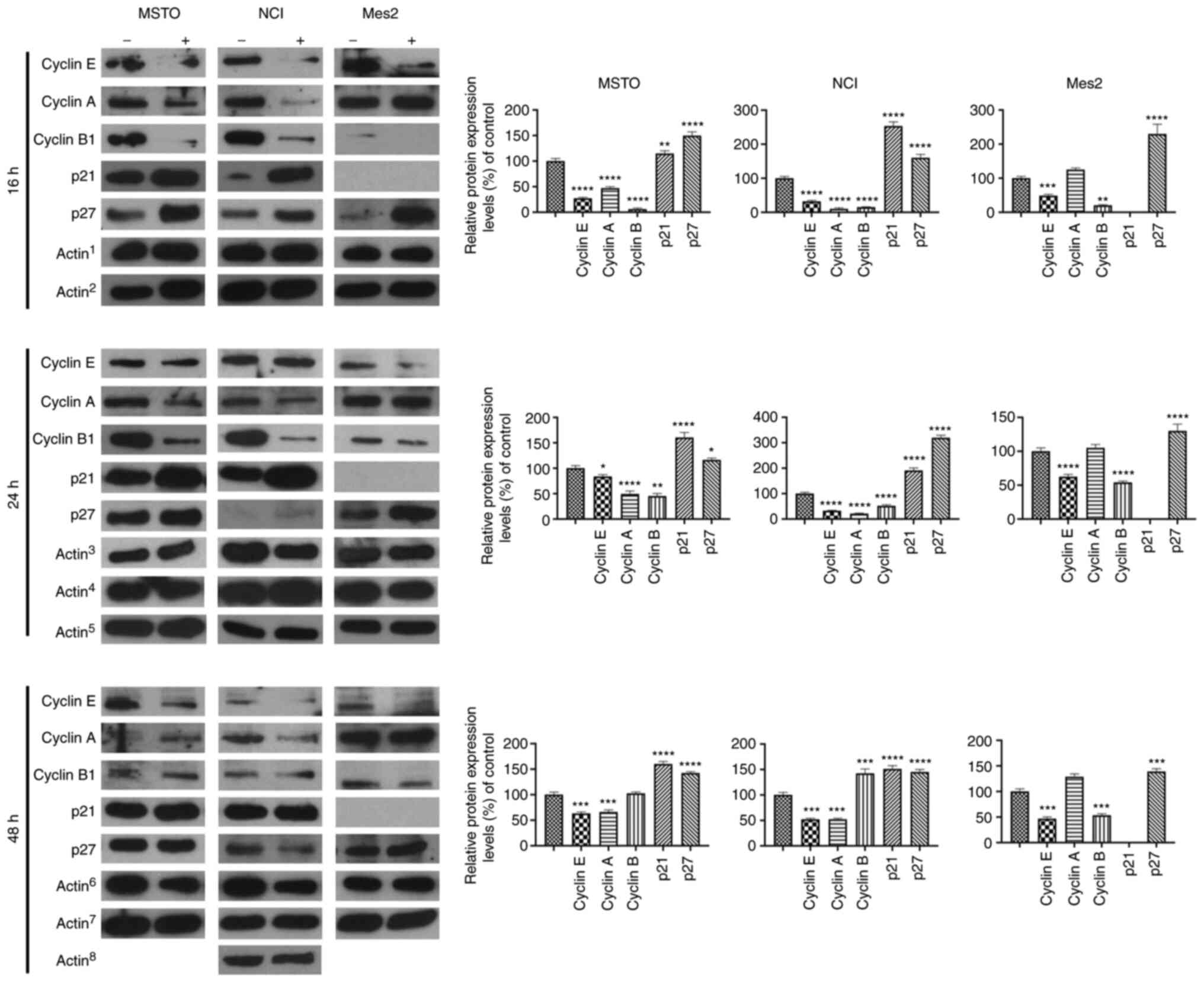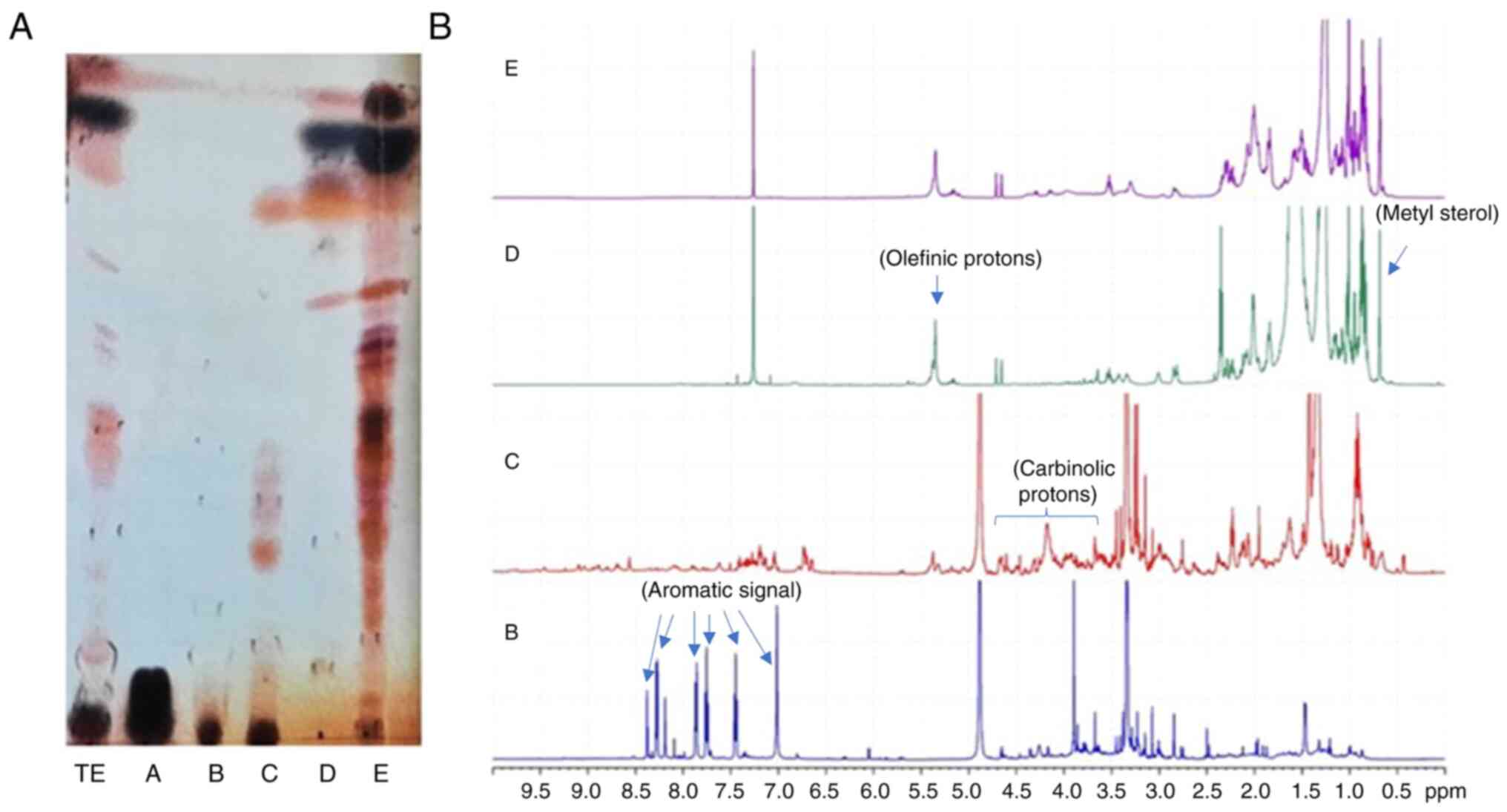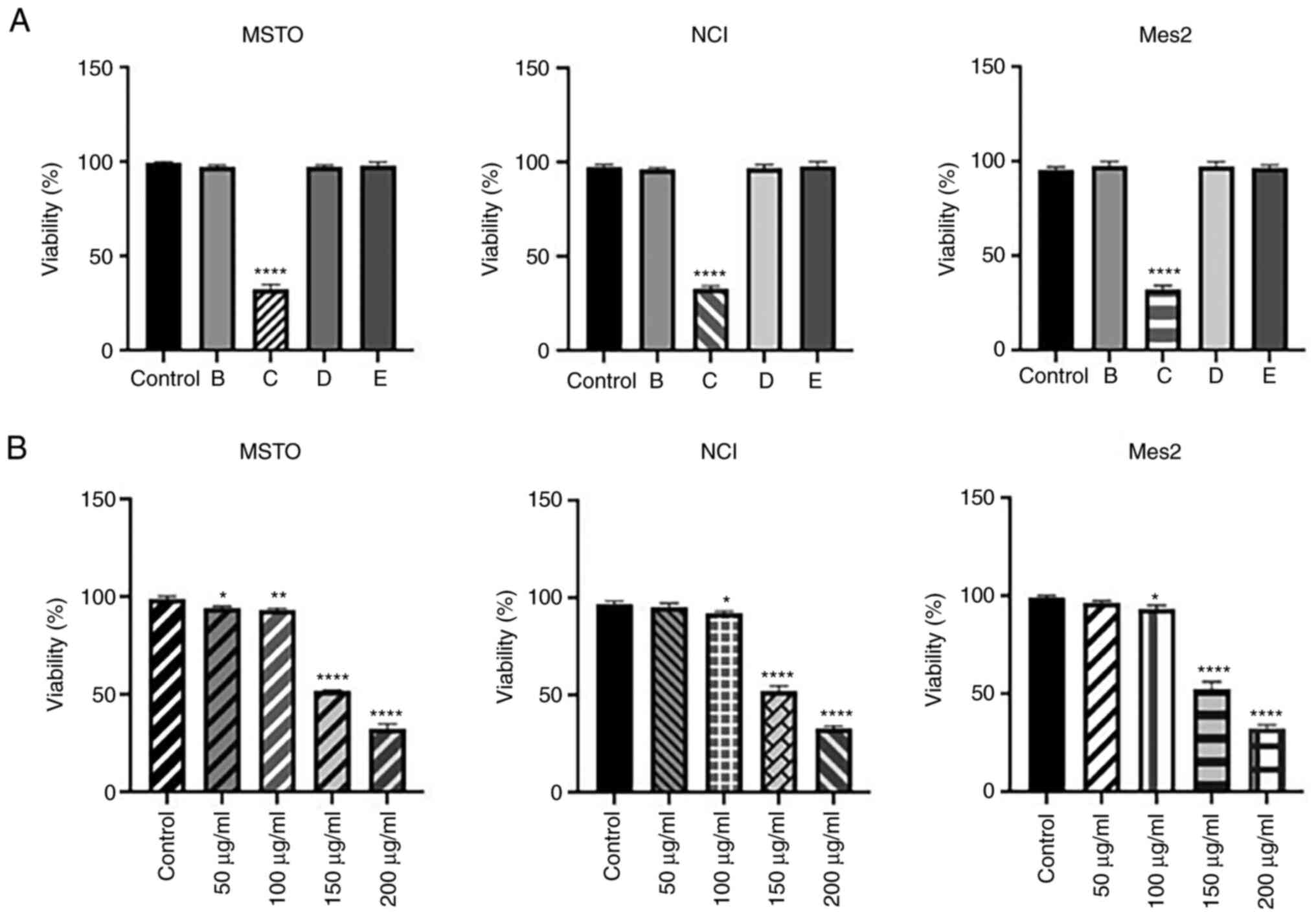|
1
|
Skropeta D, Pastro N and Zivanovic A:
Kinase inhibitors from marine sponges. Mar Drugs. 9:2131–2154.
2011. View Article : Google Scholar : PubMed/NCBI
|
|
2
|
Bailon-Moscoso N, Cevallos-Solorzano G,
Romero-Benavides JC and Orellana MI: Natural compounds as
modulators of cell cycle arrest: Application for anticancer
chemotherapies. Curr Genomics. 18:106–131. 2017. View Article : Google Scholar : PubMed/NCBI
|
|
3
|
Blunt JW, Copp BR, Keyzers RA, Munro MH
and Prinsep MR: Marine natural products. Nat Prod Rep. 31:160–258.
2014. View Article : Google Scholar : PubMed/NCBI
|
|
4
|
Mehbub MF, Lei J, Franco C and Zhang W:
Marine sponge derived natural products between 2001 and 2010:
Trends and opportunities for discovery of bioactives. Mar Drugs.
12:4539–4577. 2014. View Article : Google Scholar : PubMed/NCBI
|
|
5
|
Romano G, Costantini M, Sansone C,
Lauritano C, Ruocco N and Ianora A: Marine microorganisms as a
promising and sustainable source of bioactive molecules. Mar
Environ Res. 128:58–69. 2017. View Article : Google Scholar : PubMed/NCBI
|
|
6
|
Giordano D, Costantini M, Coppola D,
Lauritano C, Pons LN, Ruocco N, di Prisco G, Ianora A and Verde C:
Biotechnological applications of bioactive peptides from marine
sources. Adv Microb Physiol. 73:171–220. 2018.
Malve H: Exploring
the ocean for new drug developments: Marine pharmacology. J Pharm
Bioallied Sci 8, 83–91, 2016. View Article : Google Scholar
|
|
7
|
Costantini S, Romano G, Rusolo F, Capone
F, Guerriero E, Colonna G, Ianora A, Ciliberto G and Costantini M:
Anti-inflammatory effects of a methanol extract from the marine
sponge geodia cydonium on the human breast cancer MCF-7 cell line.
Mediators Inflamm. 2015:2049752015. View Article : Google Scholar : PubMed/NCBI
|
|
8
|
Costantini S, Guerriero E, Teta R, Capone
F, Caso A, Sorice A, Romano G, Ianora A, Ruocco N, Budillon A, et
al: Evaluating the effects of an organic extract from the
mediterranean sponge geodia cydonium on human breast cancer cell
lines. Int J Mol Sci. 18:21122017. View Article : Google Scholar
|
|
9
|
Crispi S, Cardillo I, Spugnini EP, Citro
G, Menegozzo S and Baldi A: Biological agents involved in malignant
mesothelioma: Relevance as biomarkers or therapeutic targets. Curr
Cancer Drug Targets. 10:19–26. 2010. View Article : Google Scholar : PubMed/NCBI
|
|
10
|
Baldi A, Piccolo MT, Boccellino MR,
Donizetti A, Cardillo I, La Porta R, Quagliuolo L, Spugnini EP,
Cordero F, Citro G, et al: Apoptosis induced by piroxicam plus
cisplatin combined treatment is triggered by p21 in mesothelioma.
PLoS One. 6:e235692011. View Article : Google Scholar : PubMed/NCBI
|
|
11
|
Cutignano A, Nuzzo G, Ianora A, Luongo E,
Romano G, Gallo C, Sansone C, Aprea S, Mancini F, D'Oro U and
Fontana A: Development and application of a novel SPE-method for
bioassay-guided fractionation of marine extracts. Mar Drugs.
13:5736–5749. 2015. View Article : Google Scholar : PubMed/NCBI
|
|
12
|
Calcabrini C, Catanzaro E, Bishayee A,
Turrini E and Fimognari C: Marine sponge natural products with
anticancer potential: An updated review. Mar Drugs. 15:3102017.
View Article : Google Scholar
|
|
13
|
Di Meo F, Filosa S, Madonna M, Giello G,
Di Pardo A, Maglione V, Baldi A and Crispi S: Curcumin C3
complex®/Bioperine® has antineoplastic
activity in mesothelioma: An in vitro and in vivo analysis. J Exp
Clin Cancer Res. 38:3602019. View Article : Google Scholar : PubMed/NCBI
|
|
14
|
Kauanova S, Urazbayev A and Vorobjev I:
The frequent sampling of wound scratch assay reveals the
‘Opportunity’ window for quantitative evaluation of cell
motility-impeding drugs. Front Cell Dev Biol. 9:6409722021.
View Article : Google Scholar
|
|
15
|
Wellington KD, Cambie RC, Rutledge PS and
Bergquist PR: Chemistry of sponges. 19. Novel bioactive metabolites
from Hamigera tarangaensis. J Nat Prod. 63:79–85. 2000. View Article : Google Scholar : PubMed/NCBI
|
|
16
|
Sipkema D, Franssen MC, Osinga R, Tramper
J and Wijffels RH: Marine sponges as pharmacy. Mar Biotechnol (NY).
7:142–162. 2005. View Article : Google Scholar : PubMed/NCBI
|
|
17
|
Varijakzhan D, Loh JY, Yap WS, Yusoff K,
Seboussi R, Lim SHE, Lai KS and Chong CM: Bioactive compounds from
marine sponges: Fundamentals and applications. Mar Drugs.
19:2462021. View Article : Google Scholar : PubMed/NCBI
|
|
18
|
Malumbres M and Barbacid M: To cycle or
not to cycle: A critical decision in cancer. Nat Rev Cancer.
1:222–231. 2001. View Article : Google Scholar : PubMed/NCBI
|
|
19
|
Lim S and Kaldis P: Cdks cyclins and CKIs:
Roles beyond cell cycle regulation. Development. 140:3079–3093.
2013. View Article : Google Scholar
|
|
20
|
Kastan MB and Bartek J: Cell-cycle
checkpoints and cancer. Nature. 432:316–323. 2004. View Article : Google Scholar : PubMed/NCBI
|
|
21
|
Bresnahan WA, Boldogh I, Ma T, Albrecht T
and Thompson EA: Cyclin E/Cdk2 activity is controlled by different
mechanisms in the G0 and G1 phases of the cell cycle. Cell Growth
Differ. 7:1283–1290. 1996.PubMed/NCBI
|
|
22
|
Harper JW, Elledge SJ, Keyomarsi K,
Dynlacht B, Tsai LH, Zhang P, Dobrowolski S, Bai C, Connell-Crowley
L and Swindell E: Inhibition of cyclin-dependent kinases by p21.
Mol Biol Cell. 6:387–400. 1995. View Article : Google Scholar
|
|
23
|
Lodén M, Nielsen NH, Roos G, Emdin SO and
Landberg G: Cyclin E dependent kinase activity in human breast
cancer in relation to cyclin E, p27 and p21 expression and
retinoblastoma protein phosphorylation. Oncogene. 18:2557–2566.
1999. View Article : Google Scholar
|
|
24
|
Lodén M, Stighall M, Nielsen NH, Roos G,
Emdin SO, Ostlund H and Landberg G: The cyclin D1 high and cyclin E
high subgroups of breast cancer: Separate pathways in tumorogenesis
based on pattern of genetic aberrations and inactivation of the pRb
node. Oncogene. 21:4680–4690. 2002. View Article : Google Scholar
|
|
25
|
Besson A, Dowdy SF and Roberts JM: CDK
inhibitors: Cell cycle regulators and beyond. Dev Cell. 14:159–169.
2008. View Article : Google Scholar
|
|
26
|
Chu IM, Hengst L and Slingerland JM: The
Cdk inhibitor p27 in human cancer: Prognostic potential and
relevance to anticancer therapy. Nat Rev Cancer. 8:253–267. 2008.
View Article : Google Scholar : PubMed/NCBI
|
|
27
|
Kreis NN, Louwen F and Yuan J: The
multifaceted p21 (Cip1/Waf1/CDKN1A) in cell differentiation,
migration and cancer therapy. Cancers (Basel). 11:12202019.
View Article : Google Scholar
|
|
28
|
Baldi A, De Luca A, Esposito V, Campioni
M, Spugnini EP and Citro G: Tumor suppressors and cell-cycle
proteins in lung cancer. Patholog Res Int. 2011:6050422011.
|
|
29
|
Bachs O, Gallastegui E, Orlando S, Bigas
A, Morante-Redolat JM, Serratosa J, Fariñas I, Aligué R and Pujol
MJ: Role of p27 Kip1 as a transcriptional regulator.
Oncotarget. 9:26259–26278. 2018. View Article : Google Scholar
|
|
30
|
Razavipour SF, Harikumar KB and
Slingerland JM: p27 as a transcriptional regulator: New roles in
development and cancer. Cancer Res. 80:3451–3458. 2020. View Article : Google Scholar : PubMed/NCBI
|
|
31
|
Gallastegui E, Biçer A, Orlando S, Besson
A, Pujol MJ and Bachs O: p27 Kip1 represses the
Pitx2-mediated expression of p21 Cip1 and regulates DNA
replication during cell cycle progression. Oncogene. 36:350–361.
2017. View Article : Google Scholar : PubMed/NCBI
|
|
32
|
Ahn JH, Woo JH, Rho JR and Choi JH:
Anticancer activity of gukulenin A isolated from the marine sponge.
Mar Drugs. 17:1262019. View Article : Google Scholar
|
|
33
|
Chikamatsu S, Saijo K, Imai H, Narita K,
Kawamura Y, Katoh T and Ishioka C: In vitro and in vivo antitumor
activity and the mechanism of siphonodictyal B in human colon
cancer cells. Cancer Med. 8:5662–5672. 2019. View Article : Google Scholar : PubMed/NCBI
|
|
34
|
Nastrucci C, Cesario A and Russo P:
Anticancer drug discovery from the marine environment. Recent Pat
Anticancer Drug Discov. 7:218–232. 2012. View Article : Google Scholar : PubMed/NCBI
|
|
35
|
Khalifa SAM, Elias N, Farag MA, Chen L,
Saeed A, Hegazy MEF, Moustafa MS, El-Wahed AB, Al-Mousawi SM,
Musharraf SG, et al: Marine natural products: A source of novel
anticancer drugs. Mar Drugs. 17:4912019. View Article : Google Scholar
|
|
36
|
Bergamaschi D, Ronzoni S, Taverna S,
Faretta M, De Feudis P, Faircloth G, Jimeno J, Erba E and D'Incalci
M: Cell cycle perturbations and apoptosis induced by
isohomohalichondrin B (IHB), a natural marine compound. Br J
Cancer. 79:267–277. 1999. View Article : Google Scholar : PubMed/NCBI
|
|
37
|
Bitzer J, Grosse T, Wang L, Lang S, Beil W
and Zeeck A: New aminophenoxazinones from a marine Halomonas sp:
Fermentation structure elucidation and biological activity. J
Antibiot (Tokyo). 59:86–92. 2006. View Article : Google Scholar : PubMed/NCBI
|
|
38
|
Sagar S, Esau L, Holtermann K, Hikmawan T,
Zhang G, Stingl U, Bajic VB and Kaur M: Induction of apoptosis in
cancer cell lines by the red sea brine pool bacterial extracts. BMC
Complement Altern Med. 13:3442013. View Article : Google Scholar : PubMed/NCBI
|
|
39
|
Rady HM, Hassan AZ, Salem SM, Mohamed TK,
Esmaiel NN, Ez-El-Arab MA, Ibrahim MA and Fouda FK: Induction of
apoptosis and cell cycle arrest by Negombata magnifica sponge in
hepatocellular carcinoma. Medicinal Chemistry Research. 25:456–465.
2016. View Article : Google Scholar
|
|
40
|
Wang R, Zhang Q, Peng X, Zhou C, Zhong Y,
Chen X, Qiu Y, Jin M, Gong M and Kong D: Stellettin B induces G1
arrest apoptosis and autophagy in human non-small cell lung cancer
A549 cells via blocking PI3K/Akt/mTOR pathway. Sci Rep.
6:270712016. View Article : Google Scholar : PubMed/NCBI
|
|
41
|
Huang RM, Chen YN, Zeng Z, Gao CH, Su X
and Peng Y: Marine nucleosides: Structure, bioactivity synthesis
and biosynthesis. Mar Drugs. 12:5817–5838. 2014. View Article : Google Scholar : PubMed/NCBI
|
|
42
|
Rajan R, Sabnani MK, Mavinkurve V, Shmeeda
H, Mansouri H, Bonkoungou S, Le AD, Wood LM, Gabizon AA and La-Beck
NM: Liposome-induced immunosuppression and tumor growth is mediated
by macrophages and mitigated by liposome–encapsulated alendronate.
J Control Release. 271:139–148. 2018. View Article : Google Scholar : PubMed/NCBI
|
|
43
|
Negi B, Kumar D and Rawat DS: Marine
peptides as anticancer agents: A remedy to mankind by nature. Curr
Protein Pept Sci. 18:885–904. 2017. View Article : Google Scholar
|
|
44
|
Sheoran A, King A, Velasco A, Pero JM and
Garneau-Tsodikova S: Characterization of tioF, a tryptophan
2,3-dioxygenase involved in 3-hydroxyquinaldic acid formation
during thiocoraline biosynthesis. Mol Biosyst. 4:622–628. 2008.
View Article : Google Scholar
|
|
45
|
Baldi A, De Luca A, Maiorano P, D'Angelo C
and Giordano A: Curcumin as an anticancer agent in malignant
mesothelioma: A Review. Int J Mol Sci. 21:18392020. View Article : Google Scholar
|
















